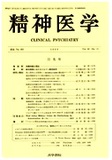Japanese
English
- 有料閲覧
- Abstract 文献概要
- 1ページ目 Look Inside
抄録 我々は,強迫症状を主症状とし,一般には強迫神経症と診断されると思われる2症例に関して,その症状の背後に観取されるうつ病的ニュアンスに注目し,これらの症例のうつ病近縁性について考察した。その結果,抑うつ気分,あるいは抑止などといった,うつ病に典型的な症状は明瞭ではなかったものの,強迫症状の発症基盤として,過去の未済,ないしは喪失という体験様式が認められた。このような体験様式は,Strausないしはvon GebsattelのいうWerdenshemmungの表現形と考えられ,この点に,これらの症例のうつ病との近縁性を求めることができるように思われた。さらに,Werdenshemmungが典型的なうつ病として現象せずに,強迫症状の形で現象した理由について,病前の人格構造との関連において考察を加え,我々の症例に認められるいわゆる「片意地の強さ」が森田の言う「精神の拮抗作用」の機制によってWerdenshemmungとの間で葛藤を起こしたものと考え,いわゆる「メランコリーの親和型性格」に基づく典型的なうつ病と対比させた。
We discussed how close to "depression" were two cases which would generally be diagnosed as obsessive-compulsive neurosis. These cases did not show evident symptoms which are typical of depression, such as depressive mood or psychomotor retardation. However, in these two cases, inability to make an end of the past, or incessant consciousness of loss were considered to lie behind the obsessive-compulsive sympoms. Both cases were recognized as expressions of "Werdenshemmung", that is, supression of "ongoing", which Straus and von Gebsattel proposed as the basic element in depression. It was thought that, because this, our cases could be said to be states close to "depression". We made further considerations concerning the reason why this "Werdenshemmung" was expressed in the form of obsessive-compulsive symptoms rather than those of typical depression. As an explanation, it was proposed that this unusual expression was conditioned by resistance against "Werdenshemmung". The personality trait of the patients under consideration may be called "obstinacy against subjection". It involves the mechanism of Morita's "psychic antagonism". We contrasted this state to that of typical depression which is thought to develop usually on the basis of "Typus melancholicus" (Tellenbach).

Copyright © 1988, Igaku-Shoin Ltd. All rights reserved.


